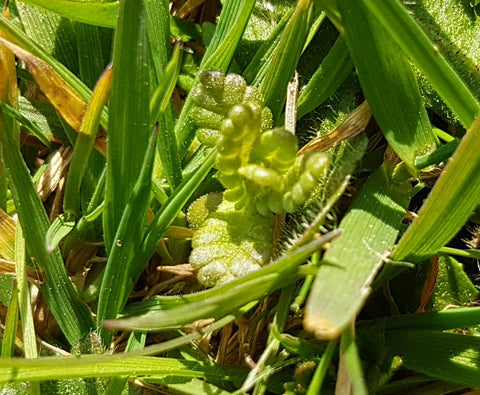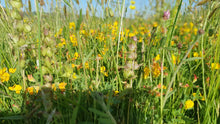Yellow Rattle seed
This is for 2025 harvest to be delivered in August 2025. You can still purchase a Yellow Rattly Mix has 50% yellow rattle in it but the yellow rattle won't successfully germinate and thrive till spring 2026.
Rhinanthus Minor: Free shipping on this item.
This is a pretty yellow flower, relatively uncommon and an essential part of any meadow on fertile soil. Its primary purpose in the meadow is to reduce the vigour of the grass, which is therefore not favoured by modern farming practices. Yellow Rattle is one of the few genuinely annual plants in a meadow. As a result, it needs careful management to ensure it can propagate itself. The plant is a sought-after species for conservationists when trying to promote biodiversity in meadows.
Yellow Rattle allows other wildflowers to germinate and compete for light by suppressing the grass. It does this by being semi-parasitic at the grassroots, thereby reducing the nutrients the grass can use. It is a favourite of the bumblebee and butterfly and a food plant of the rivulet moth. Other common names - Cock's Comb, Hay Rattle, Shackle Bags
Habitat
Usually, this will be seen in the meadows from Early March in the south and April in the northern counties and Scotland. Its preferred habitat is neutral/acidic grassland, mowed late every year. It is found from Sweden to France, and its flowering period is between May and July. The seed is easily sowed into existing grassland and is ideal for improving diversity for habitat creation.
Growing tips
This can be sown into short meadow grasses and rolled or trod in up to the end of January when it will get cold and then get direct sun two months later. Bear in mind the aspect, elevation, and shading. Removing this before germination is essential if the grass grows very fast, but it may indicate the fertility is too high.
What grasses to avoid? Cocksfoot, timothy, ryegrasses, and deeper-rooted drought-tolerant grasses are not affected by the yellow rattle and can out-compete it.
It can be not easy to grow, but it will spread rapidly when the conditions are right. The seed germinates on the surface of the soil between February and April. At this time of year, the seed will have rested for six months and will have stratified due to chilling between 5 to 10 degrees Celsius. Leaving the seeds refrigerated for six weeks is also effective, but they must be sowed into short grass and rolled in well. If conditions are right, this species will spread rapidly, so try a few strips or sow thinly across the area.
Emergence
With the right conditions and a few warm days, the seeds germinate, and depending on your latitude and local weather conditions, it throws up a small two-leafed shoot that looks a bit like jagged-edged stinging nettles. The energy in the seed is soon used up, and if the grass is too long, it won't be able to take any energy from the sun and will quickly perish. This is the main reason this seed is difficult to grow. If established successfully, its roots will parasitise onto a grass, or clover, nearby in April/ May. Without Grass, the yellow rattle will struggle to thrive and eventually perish. This delicate balance between having grass but not too long is critical for the survival of Yellow Rattle.
By late May, the plant should be beginning to flower; this is orange/red at the base as it opens, turning to yellow in full bloom. The leaves are small as it is now taking part of their nutrients from the Grass and Clovers. Flowing continues for four weeks, and by Early July, the seed pods have ripened to Golden colour and can be heard rattling in the breeze. If sufficient yellow rattle, the grass would hardly grow and, by the end of June, be relatively short and easy to Cut. 
No of seeds/g: 300
Sowing rate:
Seeds should be sown at a rate between 0.1g and 1g per square meter between August and December.
See the growing guide for detailed information on growing this seed.
Why buy from us?
This is an annual and needs to germinate every year. The seeds germinate readily but may not have the ideal growing conditions and so may perish. They also have a short shelf-life, so viability reduces with age. For the best chance of success, you need fresh seed. Our seed is guaranteed to be this season's seed, harvested from our meadows. As we harvest them ourselves, we can ensure origin, provenance, purity, minimum handling, and age. We supply only the larger grade seed, as the smaller seed may have yet to develop enough to be viable and are often confused with buttercup seeds. Also, we believe in drying the seed sparingly to mimic the natural process. On testing our seeds, we achieved 99% viability. We supply comprehensive growing and maintenance instructions to get the best results from your Yellow Rattle seed. Seeds will be posted 2ed class - generally up to 200g will be able to fit through a regular post box - or sent by courier for larger quantities (2kg+). It may contain <1% grass seed.








